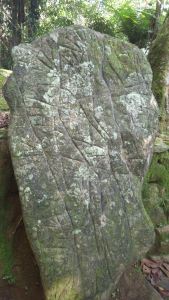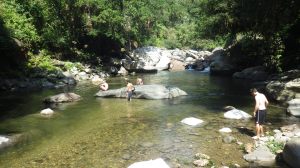While the title for this entry is a blogger’s cliché, it truly emphasises the off-the-beaten-track discovery of this remote, ancient city in the jungle. It also highlights the importance of the journey itself as part of this unforgettable experience. Unlike many sites of South American ruins (most notably Machu Picchu), La Ciudad Perdida can only be accessed by a 2-day trek along a tricky jungle track. This culminates in a (physically) breathtaking climb up 1,200 steps – and of course there’s the return hike. Like so many multi-day adventures, I was blessed with the presence of some fantastic companions, making the experience that bit more rewarding and memorable.
The Journey
Although the ‘Lost City’ trek has not yet achieved significant international fame, it certainly seems that it’s popularity is gaining steam, identified by the Santa Marta hostel offering the trip to all arriving guests. I signed up with their recommended company, ‘Guias y Baquianos’, attended the introductory meeting the night before and parted ways with 600,000 Pesos (around £200). The next morning, a minivan collected us (late) and dropped us 44 kilometres along the main road, where we changed for a more off-road vehicle to take us the final stomach-churning distance to the trailhead. After lunch we took our group photo and waved goodbye to the last traces of civilisation.
To say that the dirt road to the trailhead was undulating would be a cataclysmic understatement. And the hike itself had its generous share of climbs and descents, none worse than the exhausting first day welcoming ascent. The current droughts in northern Colombia made it a dusty affair, while the beating sun and humidity made me sweat from every imaginable pore. One lasting realisaton that I always share when discussing this trek is that I have never sweated so much in my entire life!
Dusty slopes became open hilly terrain exposed to the beating sun, then progressed to humid jungle. So when we moved into a cooler, drizzly microclimate we welcomed the refreshing rain. I took this opportunity to model my stylish new poncho (to the mixed amusement and concealed envy of my companions) to protect me and my pack from the downpour. We regularly found ourselves following the path of the valley’s river and crossings were a daily feature. Peeling off our sweaty socks and hiking boots, the cool water soothed and refreshed but at times we struggled to balance with our packs walking barefoot over rocky riverbeds.
From hilly paths we admired beautiful scenery and through dense jungle we felt humbled by this isolated, foreign environment. We glimpsed local communities, most commonly the shy yet demanding children, who were happy to pose for photos in exchange for sweets. Locals passed leading mules with supplies or the occasional lazy or injured tourist – it’s worth noting that well-fitting hiking shoes are an absolute must as some people suffered terribly from inappropriate or uncomfortable footwear.
The climate as well as the dramatically and constantly changing inclination of the trail means that the hike should not be underestimated. Another contributing factor is the trickiness of the slippery and frequently narrow rocky path, particularly on the final approach to the ‘Lost City’. Here the path is cut into the slope that rises steeply from the river far below and crosses make-shift bridges, assisted by rickety handrails that protect from vertigo-inducing drop-offs.
Once you cross the Buritaca river one last time (before the return leg at least, the final challenge to overcome is the 1,200 steps up to the ancient city. The stones laid by the Tairona people are an impressive feat of architecture but are steep, uneven and mossy. My sickness and first battle with altitude were overcome by adrenaline as I powered my way to finally reach ‘La Ciudad Perdida’.
Teyuna: The Lost City
Once everyone had made it up the mammoth staircase and recovered we began our tour of Teyuna, which is the original name of the ancient city. Our guide, Daniel, explained the history and features of the city in Spanish with a few of our bilingual companions translating to the Spanishly-challenged of us. The city is believed to have been founded around 800AD during pre-Incan times (650 years before Machu Picchu) by the Tairona people. Teyuna encompassed over 12,000 square metres and functioned as the heart of a network of villages across the Sierra Nevada.
As we followed mossy stone paths and steps joining the many stone terraces Daniel identified ceremonial features and symbols, such as a rock that is considered to be a map of the city.
He also explained defensive features including trick steps and described how priests were escorted to and performed religious rituals.
Once we reached the highest terrace, we gazed across the site and admired the architectural beauty amidst the surrounding mountain and jungle scenery. Here we took our finest photos, including a few group shots with nobody else to taint the tranquility and isolation – except some members of another group who threatened to photo bomb!
From our elevated viewpoint we learnt of the city’s abandonment caused by the invasion of the Spanish Conquistadors to the Tayrona region. Teyuna was kept secret by its inhabitants who retreated higher into the Sierra Nevada, while much of the Tayrona population was wiped out by diseases introduced by the invading Europeans.
Over time the jungle covered the city, keeping it hidden for 350 years until in 1972 some hunters stumbled upon the base of Teyuna’s mighty staircase. These men cut their way through the vines to discover the terraces where houses once stood and dug into nearby graves to loot the tombs of their golden idols and artefacts. When these artefacts started appearing on the black markets of Santa Marta, Columbian officials and archaeologists stepped in to excavate and prevent tomb-raiders from further looting.
To this day, only a quarter of the city has been uncovered so the site retains the feel of an ancient city that has been consumed by the jungle. A military presence is also felt as the site is patrolled by the Colombian Army after a guerilla group kidnapped a group of 8 foreign tourists in 2003.
The Experience
After the opening day, each subsequent day followed a similar routine. Mornings began with an early breakfast followed by half of the day’s hike. Occasionally we received fruit at strategic points to keep us refreshed and hydrated, otherwise lunch would fuel us for the afternoon hike. If we didn’t have a pre-lunch opportunity to swim in the river, this would be presented once we arrived at our campsite for the night.
This acted as the much-needed bathing and relaxation time: washing away the day’s dirt and sweat, while soothing our aching muscles. Lounging in the sun, climbing rocks and diving into the cool water beautifully balanced out the exertion of the day’s hike.
Campsites were inevitably basic. We slept in hammocks for the first two nights (Daniel actually recommended these over the unclean beds offered on the second night) but the third night was significantly more comfortable sleeping in new mattresses. Running water was unsuitable for drinking and cold, which meant very refreshing showers. Maintaining good hygiene was therefore tricky, particularly at our second campsite, where the taps barely flowed. And it was on this second night that I struggled with an uncomfortable sleep, rushing to the toilet regularly and feeling unwell. I was not suffering alone with several people throwing up and complaining of similar sickness which can probably be attributed to drinking improperly-treated water. My illness tainted my third day slightly, which was unfortunately the day we ascended to and explored the ‘lost city’, but my companions were sympathetic and prescribed me with various remedies for my unpleasant ailment.
Dinners were served to the groups as we sat along the sheltered wooden campsite benches. Afterwards our guide would brief us on the following day’s itinerary and provide us with various cultural, historical or environmental information. Daniel, a descendant of the Tairona people, always spoke passionately but reverently about each topic. The story was pieced together effectively to provide us with a broad history of the local culture and region. He conveyed the tragic truth that much of the Tairona culture was lost needlessly and yet hinted that some native people may still possess secret knowledge to where the unknown gold sources can be found.
The rest of the evenings were spent drinking cold beers and playing cards by candlelight. Out of the entire hiking group of 11, we formed a group of two girls teaching English in Mexico, two Australian guys travelling together, an Austrian girl they had met along their travels and myself. There was a fun dynamic centred around our card games at nights (mostly Presidents & A***holes, Aka Warlords and Scumbags), as well as various banter during our day’s hiking.
One of the lasting memories from the journey was our final swim, having completed the dusty descent near the end of the trail. Here we relaxed in the calm water of a partly sunlit natural pool, rewarded with some refreshing beers as we awaited the arrival of our moderately-paced and injured companions. It was indeed a slice of paradise.






























